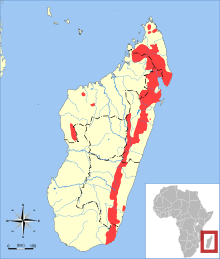Ring-tailed vontsira
The ring-tailed vontsira, locally still known as the ring-tailed mongoose (Galidia elegans) is a euplerid in the subfamily Galidiinae, a carnivoran native to Madagascar.[2]
| Ring-tailed vontsira | |
|---|---|
.jpg) | |
| Montagne d'Ambre National Park | |
| Scientific classification | |
| Kingdom: | Animalia |
| Phylum: | Chordata |
| Class: | Mammalia |
| Order: | Carnivora |
| Suborder: | Feliformia |
| Family: | Eupleridae |
| Genus: | Galidia I. Geoffroy Saint-Hilaire, 1837 |
| Species: | G. elegans |
| Binomial name | |
| Galidia elegans Saint-Hilaire, 1837 | |
 | |
| Ring-tailed vontsira range | |
_2.jpg)

Classification and etymology
There is much disagreement about the placement of Madagascar's carnivores, including the ring-tailed vontsira, within the phylogenetic tree. A 2003 study reported evidence that the Malagasy Carnivora evolved from a single herpestid ancestor.[3]
A monotypic genus, Galidia literally means "little weasel", being a diminutive form of galē (γαλῆ, "weasel" in ancient Greek).[4] Its local common name is vontsira mena, ‘red vontsira’ in Malagasy.[5]
Description
The ring-tailed vontsira is relatively small but is the largest member of the subfamily Galidiinae. It is usually 32 to 38 cm (12.5 to 15 in) long and weighs only 700 to 900 g (25 to 32 oz). Its body is long and slender, and the rounded head has a pointed snout. The body is a dark red color and the feet are black. As the name implies, its bushy tail is covered with black and red rings and is similar to the red panda.
Ring-tailed vontsira are very agile, and good climbers. They are quite playful and are active during the day. Their habitat consists of humid forests. Their diet is mostly of small mammals, invertebrates, fish, reptiles and eggs, but they occasionally eat insects and fruit.
The population of ring-tailed vontsira has decreased by 20% during the period 1989-1999 due to habitat loss.[6] Another problem is competition with the small Indian civet (Viverricula indica).
References
- Hawkins, A.F.A. (2008). "Galidia elegans". IUCN Red List of Threatened Species. 2008. Retrieved 22 March 2009.CS1 maint: ref=harv (link) Database entry includes a brief justification of why this species is of least concern
- Wozencraft, W.C. (2005). "Order Carnivora". In Wilson, D.E.; Reeder, D.M (eds.). Mammal Species of the World: A Taxonomic and Geographic Reference (3rd ed.). Johns Hopkins University Press. pp. 532–628. ISBN 978-0-8018-8221-0. OCLC 62265494.
- Yoder, Anne D.; Burns, Melissa M.; Zehr, Sarah; Delefosse, Thomas; Veron, Geraldine; Goodman, Steven M.; Flynn, John J. (2003). "Single origin of Malagasy Carnivora from an African ancestor". Nature. 421 (6924): 734–737. doi:10.1038/nature01303. PMID 12610623.
- Merriam-Webster Unabridged Dictionary
- Blench, Roger and Martin Walsh, Faunal names in Malagasy: their etymologies and implications for the prehistory of the East African coast (2009)
- Nick, Garbutt (2007-01-01). Mammals of Madagascar : a complete guide. Yale University Press. ISBN 978-0300125504. OCLC 154689042.
External links
- Animal Diversity Web Ring-tailed mongoose
- Malagasy ring-tailed mongoose (Galidia elegans) - ARKive.org
